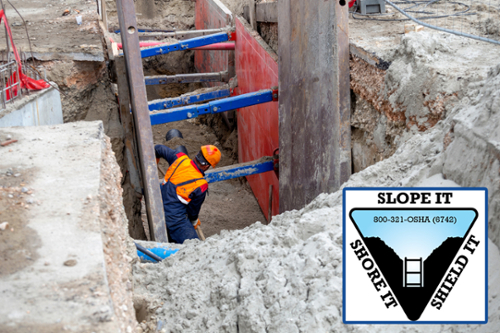In response to the U.S. Department of Labor’s announcement in July of an “alarming” increase in trench and excavation deaths – 22 so far this year compared to 15 in all of 2021 – OSHA announced “enhanced nationwide enforcement and oversight” to protect workers. Employees exposed to soil excavations deeper than 5 feet are encouraged to “Slope It. Shore It. Shield It.” SLOPE or bench trench walls; SHORE trench walls with supports; and SHIELD trench walls with trench boxes. These steps, along with the following five tips, can save lives:

Consejos de Seguridad para las Zanjas
En los primeros seis meses de 2022, 22 trabajadores han sido víctimas de peligros mortales relacionados con zanjas y excavaciones. Para evitar derrumbes: Incline. Apuntale. Proteja”. INCLINE o construya bancos en las paredes de las zanjas. APUNTALE las paredes de las zanjas con soportes; o PROTEJA las paredes de las zanjas con cajas de zanjas.
Estos consejos pueden salvar vidas.
- Asegure una entrada y salida segura en la zanja.
- Las trincheras deben de tener protección contra derrumbes.
- Mantenga los materiales del borde de la zanja.
- Esté al pendiente de agua estancada u otros peligros.
- Nunca ingrese a una zanja a menos que haya sido inspeccionada.
Para reportar una zanja insegura, llame al 800-321-6742.
1 Ensure safe entry and exit.
Keep ladders, steps, or ramps within 25 feet of all workers in trenches to ensure safe entry and exit.
2 Trenches must have cave-in protection.
Shielding stops movement if the earth starts to shift. It also protects workers from the pressure and weight of soil in the event of a cave-in. One cubic yard of soil can weigh as much as 3,000 pounds.
3 Keep materials away from the edge of the trench.
Keep all tools and any loads that put extra pressure on the earth, such as excavated soil and equipment, at least 2 feet from the trench edges. Never work under a raised load.
4 Look for standing water or other hazards.
Water in a trench can weaken its sides and make it more difficult for workers to get out. OSHA does not allow workers to enter a trench containing water without special support or shield systems to prevent cave-ins; water removal to control the water level; or the use of a safety harness and lifeline.
5 Plan for after the storm.
A competent person must inspect trenches at the start of each shift and following a rainstorm. The trench must be free of standing water and other dangers, such as low oxygen or hazardous vapors and gases.
To report an unsafe trench call 800-321-6742.
For more information on trenching and excavation safety, download or stream any of DWC Workplace Safety’s free health and safety publications or videos. The Texas Occupational Safety and Health Consultation (OSHCON) program provides free and confidential onsite or virtual assistance with OSHA compliance and workplace injury and illness prevention, including trench-related safety. Contact an OSHCON consultant at safetytraining@tdi.texas.gov or 800-252-7031, option 2. Visit www.txoshcon.com for more details.
